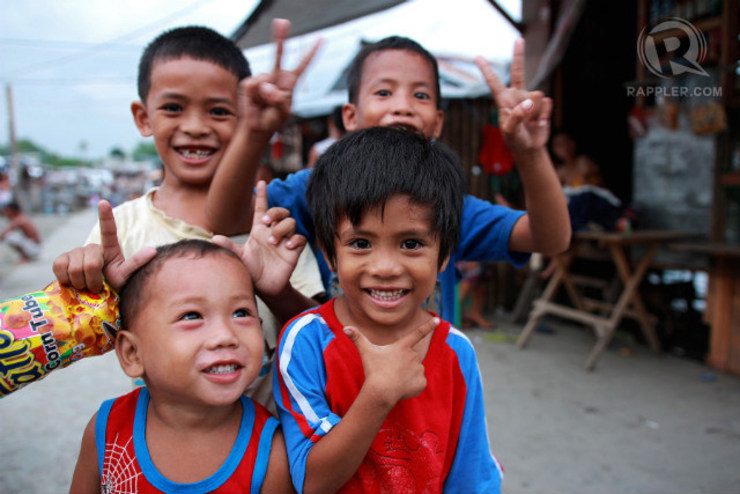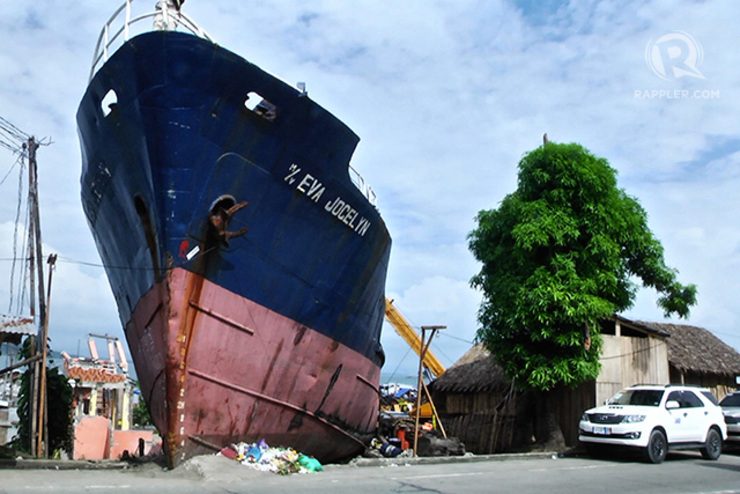SUMMARY
This is AI generated summarization, which may have errors. For context, always refer to the full article.

TACLOBAN CITY, Philippines – A smiling 5-year-old boy carried a rooster, his friends played street games, and the grown-ups erupted in laughter in Anibong, a village swallowed by the sea during Super Typhoon Yolanda (Haiyan) on November 8, 2013.
From the shanties that residents rebuilt here, a sense of normalcy filled the air, accompanied by the fishy smell of the sea.
At the same time, two ships remained grounded in this seaside community Wednesday, November 5.
The ships in Anibong – featured in iconic photographs on Yolanda’s impact – serve as a grim reminder that this place is, in the government’s words, a danger zone.
Still, around 3,000 families, or 14,100 people, continue to live in danger zones close to the sea, Tacloban Mayor Alfred Romualdez told Rappler.
The Tacloban City government is set to prohibit residents from building houses in danger zones, also known as “no-dwelling” or “no-build zones,” to avoid a repeat of Yolanda that killed 6,300 people here.
Thousands of others live in danger zones farther from the waters.
“Wala kasing paglilipatan eh,” Romualdez said. (There’s nowhere to move to.)
Residents in Anibong form part of the 14,000 families, or 68,150 Tacloban residents, who needed permanent houses after Yolanda. (READ: Yolanda a year after: Only 2% of needed houses to be built by Nov 8)

‘Prioritize no-build zones’
In Anibong, Yolanda survivors cite various reasons why they haven’t moved to safer houses.
Many of them said they’re waiting for the local government’s go-signal on when they can leave Anibong. Others refused to leave because Anibong is closer to their workplaces.
The common factor is, they feel they have no choice.
Elma Delingol, a 48-year-old Anibong resident, finds it “unfair,” not just because they haven’t moved to permanent shelters yet – she also complained that relief goods often go to bunkhouse residents. Delingol appealed for relief goods and financial aid. (READ: Yolanda bunkhouse residents: ‘Give us cash’)
Residents said the government stopped giving them relief goods in March.
“Dapat sana dito ang priority nila sa no-build zone,” she said. (They should be prioritizing us, here in the no-build zone.)
Richelle Alcaraz, 26, shared Delingol’s concern. “Sa bunkhouse, panay pa sila ng suporta doon. Bakit kami, hindi ba kami dumaan sa bagyo na hindi nila kami kayang suportahan ng pagkain? Tapos ‘yung bunkhouse, punong puno na ng pagkain, pinamementa na lang dito sa barangay namin,” she said.
(They’re fully supporting those in bunkhouses. Why, didn’t we undergo a typhoon, and they can’t support us with food? Then those in the bunkhouses overflow with food, they sometimes sell these goods here in our village.)

Prioritizing tents
Romualdez, for his part, promised to move them into permanent shelters out of the danger zones.
The mayor, however, said he will prioritize Yolanda survivors still living in tents.
He said those in coastal areas like Anibong, after all, have houses to protect them when it rains. When there’s a storm, they can also evacuate with the government’s help, he said.
Romualdez noted, on the other hand, that even the weakest storms can blow a tent away, and the lightest rains can flood these. He also described tent dwellers as more vulnerable to disease.
“Our focus really now is getting people out of tents and moving them into transitional houses,” Romualdez said.
Data from the Tacloban City government show 1,053 families, or almost 5,000 Yolanda survivors, live in bunkhouses; 436 families, or around 2,000 people, in other forms of temporary shelters; and 353 families, or more than 1,600 individuals, in tents.
In the meantime, the 3,000 families living in the danger zones fear the next typhoon. – Rappler.com
Add a comment
How does this make you feel?
There are no comments yet. Add your comment to start the conversation.